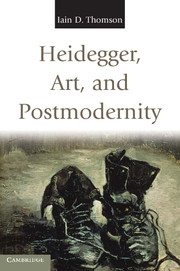Book contents
- Frontmatter
- Contents
- List of Illustrations
- Acknowledgments
- Abbreviations Used for Works by Heidegger
- A Note on the Notes (Redux)
- Introduction
- 1 Understanding Ontotheology, or “The History that We Are”
- 2 Heidegger's Critique of Modern Aesthetics
- 3 Heidegger's Postmodern Understanding of Art
- 4 “Even Better than the Real Thing”?
- 5 Deconstructing the Hero
- 6 The Philosophical Fugue
- 7 The Danger and the Promise of Heidegger, an American Perspective
- 8 Against Conclusions
- References
- Index
3 - Heidegger's Postmodern Understanding of Art
Published online by Cambridge University Press: 05 June 2012
- Frontmatter
- Contents
- List of Illustrations
- Acknowledgments
- Abbreviations Used for Works by Heidegger
- A Note on the Notes (Redux)
- Introduction
- 1 Understanding Ontotheology, or “The History that We Are”
- 2 Heidegger's Critique of Modern Aesthetics
- 3 Heidegger's Postmodern Understanding of Art
- 4 “Even Better than the Real Thing”?
- 5 Deconstructing the Hero
- 6 The Philosophical Fugue
- 7 The Danger and the Promise of Heidegger, an American Perspective
- 8 Against Conclusions
- References
- Index
Summary
The essence of art consists … in the artist possessing the essential insight for the possible, for bringing the hidden possibilities of what-is into the work and thereby making human beings first able to see what that with which they blindly busy themselves really is.
Heidegger (ET 47/GA34 63–4)They will never be able to understand what painting is. They cannot understand that the figure of a laborer – some furrows in a ploughed field, a bit of sand, sea and sky – are serious subjects, so difficult, but at the same time so beautiful, that it is indeed worthwhile to devote one's life to expressing the poetry hidden in them.
Vincent van Gogh (letter to Theo van Gogh, 9 August 1882)INTRODUCTION: THE THREE PILLARS OF HEIDEGGER'S UNDERSTANDING OF ART
“The Origin of the Work of Art” – an essay Heidegger delivered repeatedly between 1935 and 1936, rewriting and expanding it into three lectures (which became the three main sections of the published essay, to which he added a brief “Afterword” near the end of the 1930s and a slightly longer “Addendum” in 1957) – is far and away the most important source for understanding Heidegger's attempt to articulate an alternative to the aesthetic understanding of art, although several other works (contemporaneous as well as later) also provide important clues to his view.
- Type
- Chapter
- Information
- Heidegger, Art, and Postmodernity , pp. 65 - 120Publisher: Cambridge University PressPrint publication year: 2011



